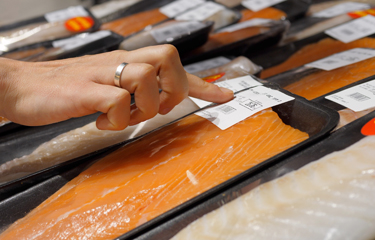A new survey shows that inflation that is sending seafood prices higher may discourage Americans from indulging during the Thanksgiving holiday.
The price of meats, poultry, fish, and eggs increased 11.9 percent in October, according to the U.S. Bureau of Labor Statistics’ Consumer Price Index. As a result, 78 percent of consumers say rising prices will impact their Thanksgiving grocery shopping, and 37 percent expect higher costs to have a significant impact on their food spending, according to new survey data from Numerator. Fourteen percent of shoppers said they will not purchase turkey for Thanksgiving this year, while 16 percent said they will omit meat and seafood. And 21 percent said they will reduce the size of their Thanksgiving gathering this year due to rising prices.
Not everyone is cutting back – IRI’s recent consumer survey found that 22 percent of Americans expect to spend more on Thanksgiving dinner than they did last year, in part because of inflation. The average party size is also expected to be bigger this year, at an average of seven to eight people. E-commerce platform Field Agent also found that 34 percent of U.S. shoppers will spend more on holiday groceries this year.
Despite the fact that fresh seafood prices rose 12.9 percent in October year-over-year to USD 9.06 (EUR 8.00) per pound on average, IRI and 210 Analytics Principal Anne-Marie Roerink told SeafoodSource she believes seafood sales will be strong through the holiday and the rest of the year.
“Yes, we have seen significant inflation in seafood, but it’s important to keep in mind that the core seafood consumer is high-income,” Roerink said. “These households have more disposable income and tend to be less affected by inflationary or recessionary pressures.”
It helps that seafood price-hikes were less than other meats in October, Roerink said. The price index for beef soared 20.1 percent, while the pork index was up 14.1 percent, its largest 12-month increase since the period ending December 1990, according to the U.S. BLS.
While there will be some “switching, with some trading down or trading out” by shoppers, the price elasticity for seafood tends to be higher than that of other items around the store, Roerink said. Plus, she said, Americans are looking for the immunity boost and other health benefits that seafood offers.
“I think this is a really important time to address seafood’s very strong ‘why.’ COVID-19 is still around, flu season has started, immunity and healthful choices are important,” Roerink said. “Seafood has a very strong health halo and a great sustainability story and those are important points to underscore when people have to pay a little more.”
Also helping is that, through the COVID-19 pandemic, shoppers have gotten accustomed to switching back and forth between fresh and frozen, Roerink said.
“This month, we saw some pressure on fresh seafood sales, but frozen came on strong, as did shelf-stable, for that matter,” she said. “I think the story of seafood performance has many more layers than inflation alone. But if we look at seafood holistically – frozen, fresh, and shelf-stable – I think these next few months are still going to see some good results.”
Fresh seafood prices rose in October due to inflation and overall sales declined slightly (0.5 percent) to USD 584 million (EUR 515 million), versus October 2020. Frozen seafood sales soared 8.1 percent versus October 2020, and was up 38.7 percent versus October 2019.
In response to concerns over inflation, seafood retailers might consider smaller package sizes, which is a frequent practice used with beef when prices are high, Roerink said.
"During times of high inflation, steaks get a little thinner to continue to sit in the consumer price sweet-spot,” Roerink said. “Consider some smaller portions in pre-packaged and also consider value-added, where people have yet another reason to make room in their budget for something a little more expensive.”
Roerink said while her prognostication for seafood is brighter than that of other proteins, American buying-habits are still difficult to predict.
“Twenty months into the pandemic, seafood retailing remains in flux,” Roerink said. “Continually changing consumer consumption and buying patterns, high inflation, and severe supply-chain constraints have yet to create a new and lasting balance of supply and demand.”
Photo courtesy of Sia Footage/Shutterstock







